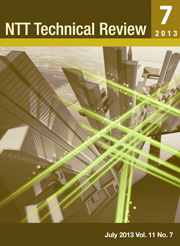
You need Adobe Reader 7.0 or later in order to read PDF files on this site.
If Adobe Reader is not installed on your computer, click the button below and go to the download site.

|

Front-line Researchers
-
 Masaaki Nagata, Senior Distinguished Researcher, NTT Communication Science Laboratories Masaaki Nagata, Senior Distinguished Researcher, NTT Communication Science Laboratories

Abstract
A translation machine that would allow anyone to communicate smoothly in real time with people in all sorts of countries and regions sounds like a fantasy, but the day that such a machine becomes a reality is not really that far away. Senior Distinguished Researcher Masaaki Nagata is a leading researcher of natural language analysis in Japan. We asked him to tell us about trends and issues in machine translation as well as his views on what being a researcher means.
Feature Articles: Intelligent Spoken Language Interface Technology for Various Services
-
 Toward Intelligent Spoken Language Interface Technology Toward Intelligent Spoken Language Interface Technology

Abstract
The spoken language interface has become much more prominent in recent years, as services for smartphones that take speech input for search functions and provide answers in the form of synthesized speech have grown in popularity. This article describes work being done at the NTT Media Intelligence Laboratories aimed towards implementing intelligent spoken language interface technology to support a variety of services.
-
 Speech Recognition Technology That Can Adapt to Changes in Service and Environment Speech Recognition Technology That Can Adapt to Changes in Service and Environment

Abstract
Speech recognition is a technology that recognizes spoken words. Speech recognition is a fundamental function for speech and language interfaces, and its quality strongly affects interface usability. Therefore, the recognition accuracy should always be high. However, recognition accuracy can drop significantly if there are changes in the service or the use environment. In this article, we introduce research being carried out to tackle this problem.
-
 Knowledge Extraction from Text for Intelligent Responses Knowledge Extraction from Text for Intelligent Responses

Abstract
In this article, we describe a linguistic analysis technique for extracting useful knowledge from the vast amounts of text on the World Wide Web. First, we introduce a technique for extracting named entities as a key to knowledge to be handled by a computer, and then we show how this can be applied to extract relations between named entities.
-
 Question Answering Technology for Pinpointing Answers to a Wide Range of Questions Question Answering Technology for Pinpointing Answers to a Wide Range of Questions

Abstract
Question answering technology that provides pinpoint answers to a wide range of questions is expected to make speech interfaces more intelligent. This article describes question answering technology and reviews past and current approaches to it at NTT.
-
 Speech Synthesis Technology to Produce Diverse and Expressive Speech Speech Synthesis Technology to Produce Diverse and Expressive Speech

Abstract
We have been developing a new text-to-speech synthesis system based on user-design speech synthesis technology that can be extensively applied to various fields. The technology yields speech with rich expression and various characteristics and thus replaces existing synthesized speech systems that have a limited range of voices or speaking styles. This article introduces this new system that represents the future of speech synthesis technology.
Regular Articles
-
 Multichannel Audio Transmission over IP Network by MPEG-4 ALS and Audio Rate Oriented Adaptive Bit-rate Video Codec Multichannel Audio Transmission over IP Network by MPEG-4 ALS and Audio Rate Oriented Adaptive Bit-rate Video Codec

Abstract
This article describes an experiment of lossless audio transmission over an Internet protocol (IP) network and introduces a prototype codec that combines lossless audio coding and variable bit rate video coding. In the experiment, 16-channel acoustic signals compressed by lossless audio coding (actually, we used the MPEG-4 Audio lossless coding (ALS) standardized by Moving Picture Experts Group) were transmitted from a live venue to a cafe via the IP network. At the cafe, received sound data were decoded losslessly and then appropriately remixed to adjust to the environment at that location. The combination of high-definition video and audio data enables fans to enjoy a live musical performance in places other than the live venue. This experiment motivated us to develop a new prototype codec that guarantees audio quality. The developed codec can control the bit rates of both audio and video signals jointly, and it achieves high audio and video quality.
-
 Distributed Array Antenna Technique for Satellite Communications Distributed Array Antenna Technique for Satellite Communications

Abstract
NTT Access Network Service Systems Laboratories has developed a distributed array antenna (DAA) technique to achieve a higher gain earth station antenna for satellite communications. The DAA configuration comprises several smaller antennas and has an antenna gain equivalent to that of a conventional large-aperture antenna. We applied the configuration to two antennas and experimentally confirmed that the DAA achieves increased antenna gain.
Global Standardization Activities
-
 Development of ITU-T Action Plans for New Study Period at WTSA-12 Development of ITU-T Action Plans for New Study Period at WTSA-12

Abstract
WTSA, the World Telecommunication Standardization Assembly, is the highest-level assembly of the International Telecommunication Union, Telecommunication Standardization Sector (ITU-T). The most recent assembly, WTSA-12, was held in Dubai, United Arab Emirates (UAE), in November 2012. The purpose of the assembly was to develop the ITU-T action plans for the new study period from 2013 to 2016. Three Study Group vice-chairmen were elected from NTT. This article introduces the major results of WTSA-12.
NTT around the World
-
 NTT Beijing Representative Office NTT Beijing Representative Office

Abstract
Located in Beijing, China, the NTT Beijing Representative Office is the holding company's only Asian office outside of Japan, and it serves to support the global expansion of the NTT Group's business from an overseas viewpoint.
This article describes how the NTT Beijing Representative Office supports the global implementation of research and development results in the course of its main activities, and outlines the latest trends of NTT Group business companies in China.
External Awards
|
